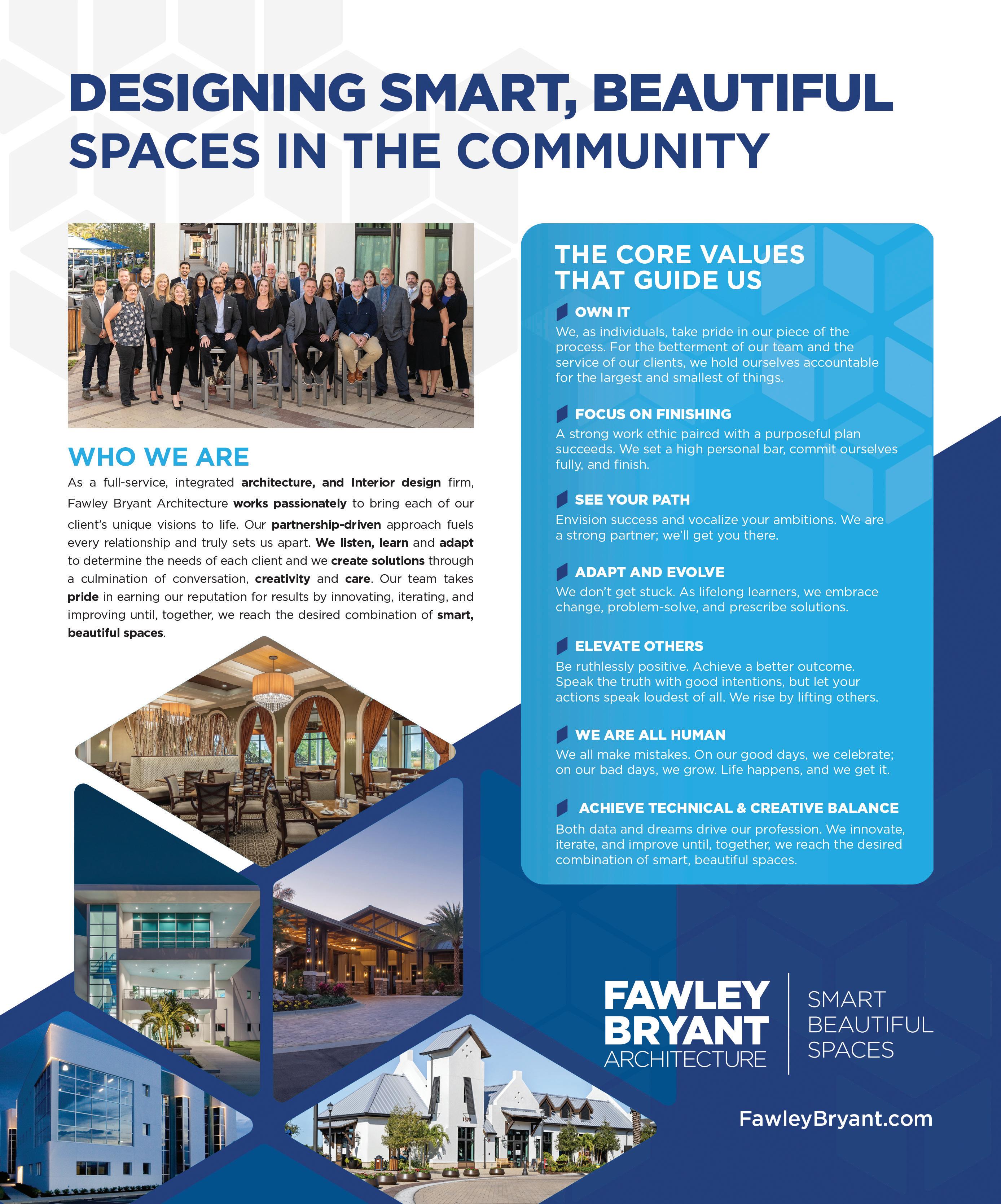In Conversation
IN CONVERSATION ON GROWING LAKEWOOD RANCH WITH FAWLEY BRYANT


ARCHITECTS
 INTERVIEW BY WES ROBERTS
EDITED BY BARBIE HEIT
INTERVIEW BY WES ROBERTS
EDITED BY BARBIE HEIT
were actually the architects for the SMR headquarters. So early on we were involved in conversations about long-term planning, what their vision was, and what they were trying to do. We were very much interested in what that was and what that meant for us, being in Manatee County, and then also Sarasota County. We moved our headquarters here in 2008 and SMR was a partner of ours in this building. So again, partners from the very beginning. And we did that for a lot of reasons: recruiting, bringing in people further south that maybe we couldn’t get from downtown Bradenton. Also, people from further north because we had more access to the interstate, being part of a planned development, and having access early on to things like educational projects. government projects and sports and recs. We did a lot of country
clubs, so that fit really nicely in our portfolio. It came down to people. Just having relationships with the people that had a big idea that we wanted to be a part of and could help out in any way possible.



CAN YOU SPEAK A BIT ABOUT RICK FAWLEY AND MIKE BRYANT AND HOW THEIR VISION ECHOES IN THE FIRM TODAY?
PADGETT: Rick Fawley was our original president. Mike Bryant was vice president. They are the founding fathers of Fawley Bryant. They both had their own individual firms in Manatee County. They came together to work on a project for Manatee High School. Partly, they were banding together to try and keep the outsiders out, and keep the insiders in. And they got the project that worked well and they stayed together.
So their partnership was born out of somewhat necessity but trying to keep local groups local. Rick was the community guy. He had all the relationships, he was out and about. Mike was really more of the business-minded guy, he was looking at the schedules and the budgets and the sta ng needs. I think Stu and I are very similar in personality to each of them. Probably a bit more of a blend than they were, but same kind of idea. Still, community is extremely important to us. We still work in this community and we’ve extended it from Lakewood Ranch to Manatee County, the city of Bradenton, Sarasota, the city of Sarasota, North Port, and now Wellen Park. So we’ve continued to build on those relationships over time. But a big part of that really was just knowing the right people, being someone you trust, someone you respect, and really
SPRING 2023 EDITION ENGAGING READERS THROUGH STORYTELLING.
ABOUT THE PARTICIPANTS

STU HENDERSON
A graduate of The University of Cincinnati’s School of Design, Art, Architecture and Planning, Stu joined Fawley Bryant in 2011. A er moving from Erie, PA where he taught at Mercyhurst University for seven years, Stu returned to the field of architecture in the Bradenton/ Sarasota area. Stu plays a key role at Fawley Bryant with his ability to turn a conceptual vision into reality. His creative pragmatism has played a fundamental role in the completion of large-scale sports and education projects like IMG Academy’s West Campus and Binghamton University’s Baseball Complex. His 3D modeling and technological abilities allow clients and team members to visualize project considerations from a tangible and intuitive perspective. Stu currently serves as a Board Member for the Manatee Chamber of Commerce and Leadership Manatee’s 2019 class.
STEVE PADGETT
A Florida native and graduate of Clemson University, Steve joined Fawley Bryant in 2001 and has seen tremendous changes and growth in the region. Steve is engaged in the firm’s operations and helped fuel the initial development and expansion of Fawley Bryant’s sports division, including projects for the Pi sburgh Pirates, Atlanta Braves, IMG Academy, and Gatorade Sports Science Institute. He currently works with our government partners including the Sarasota County Administrative Center and Bradenton Area Convention Center to lead our region forward. Steve is an active project architect who is passionate about the development of our community. Steve serves as a Board Member for Gulf Coast Builders Exchange and Leadership Sarasota class of 2016.
bouncing o conversations about what could a place like Lakewood Ranch be—what are the things that you need to create identity?
AS A FIRM THAT’S BEEN A CONTRIBUTOR TO LAKEWOOD RANCH FROM THE EARLY CONCEPTUAL STAGES, HOW WOULD YOU DESCRIBE THE ARCHITECTURAL PERSONALITY OF LAKEWOOD RANCH?
HENDERSON: I think they started with some guidelines on what they wanted to see out here, which was almost ranchy, and had sort of a natural stone look to it. That really evolved. It’s a beautiful community. There are some gems of buildings that are out here, and I really enjoy the diversity of the architectural styles that are here, from LECOM, the two buildings halfway up Lakewood Ranch Boulevard, to the lodge that we had done a couple of years ago, Rick Fawley’s last project. And I was proud to partner with him on the design of that, it’s beautiful and gets a lot of nice remarks. Now too, Waterside place. So it’s really an evolving, healthy, evolving community design-wise, from an architectural standpoint.
THE COMMUNITY IS IN A LOT OF WAYS STILL YOUNG. WHAT ARE SOME OF THE BUILDINGS AND STRUCTURES—YOURS AND OTHERS—THAT YOU THINK WILL STAND THE TEST OF TIME AND HELP BECOME THE SIGNATURE IMAGE THAT PEOPLE HAVE WHEN THEY VISIT LAKEWOOD RANCH?
HENDERSON: Some communities are blessed with the ability to have a blank slate and start with a strategy and a plan. Others have to evolve, and they fi nd these areas that people remember about the community. So here, I think the forward-thinking planning of
Lakewood Ranch, Main Street, Waterside, and then where maybe the medical component might be, the entertainment, and sports area. I really love the diversity of the buildings that are around. I think that Lecom, standing large on Lakewood Ranch Boulevard is memorable, and the beginning of a nice campus language. Premier sports, we had little, playful buildings out there. It’s not meant to be about the buildings at that point. And then the country clubs, that sort of identifies di erent areas and maybe even mindsets of going to the marble floors, a grand stair of the main clubhouse, the beautiful back area that we were lucky enough to participate in, to design the fi re pit area back there in the coverage area. And then, really I think the thing that people remember is the high quality of Waterside Place. The high quality of the thinking, the execution of the design, and the wonderful community spaces that come together. The quality of the landscaping and landscape architecture is just fantastic. And then the events and the vendors that come in there in addition to the shop owners, all very high quality. And I think that’s going to last for a very long time and people are going to enjoy going there. PADGETT: Yeah, I think one of the easy answers is, it’s grown so much and it’s been so successful in planning. They’ve created diverse buildings and developed neighborhoods that people will want to go to in Lakewood Ranch for those di erent experiences.
IN













TERMS OF YOUR OWN FIRM,

WHAT ARE THE AREAS THAT YOU FOCUS ON? HENDERSON: At Fawley Bryant, we started with the educational model. We did a lot of schools with Rick and Mike. We had a great relationship with the Pittsburgh Pirates,
ultimately IMG. We started to do some work there. Rick was the fi rst one to do some work there as well, so we took those relationships and really tried to drive those home. Lots of sports work, we do about 50% in sports. We do a lot of government, municipal work, and education is still something that we enjoy doing. Those are the primary markets, and about 50% lands in sports.
WHEN YOU BEGIN TO WORK WITH A CLIENT, WHAT IS THE PSYCHOLOGICAL PART OF THAT PROCESS LIKE? WHERE DO YOU FIND OUT WHAT THEY’RE LOOKING FOR WITH THEIR CREATIVITY?
HENDERSON: In a lot of ways, it’s a conversation. We’ll ask, what have you seen that you’ve liked? What would you like us to look at when we come to work with you? So you might get some insight there into what their perspective is in general. We try to fi nd out what the building should be and make sure that that works within budget. But in a lot of ways, we try to understand, the project may not be about the building. The project is about serving the clients, it’s about a backdrop for sports. So it’s not the place to spend money. We want to make sure we’re being very good stewards of the finances of the total project, not just the architectural component. So if it turns out that it’s a background building, as we call it, it may just have an interesting paint job. It’s not really about major architectural forms and glass and cavaliers, it may be about being simple and e cient and beautiful in that way.
PADGETT: I think a lot of it is just really what the image of the client wants. Some want to be conservative and they want to be a little bit conservative with their spending and some want to make a statement. They want a signature
20 | SRQ MAGAZINE | LIVING LAKEWOOD _ MAR 23 LIVE LOCAL GROWING LAKEWOOD RANCH :: SPRING 2023 IN CONVERSATION

building, they want that to attract them. But in all cases, it is their identity. So a lot of that conversation is, what do you want it to be?
ARE THERE ANY PARTICULAR ANECDOTES YOU COULD TELL US ABOUT WHERE YOU WERE ENGAGING WITH A CLIENT AND IT WAS AN ESPECIALLY EXCITING CONVERSATION THAT SPOKE TO THE CREATIVITY THEY WERE LOOKING FOR?







HENDERSON: At Fawley Bryant, we do work outside of the area as well. One of the benefits of doing that work outside of the area is we can bring that knowledge home, where it can be found in our projects to serve schools, which serve our kids. In government work, it serves everybody in the community. And then sports, it’s translating what we’ve done maybe in other areas, back into what we do here at home. We did have a client up in New York, where it was all about the cost, so we had to be very cost conscious. The client really was a visionary and wanted to push us in a lot of ways to do better work. In that case, it was fi nding the right solution fi rst. So material-wise, you may immediately think, “Well, marble’s too expensive” or “granite is too expensive,” but if it’s the right material for the qualities and properties of the job, then he would want that in the project. So we still were very good stewards of his money, but he did push us to expand our thinking, and serve the university more, and at one point, he said, “I think this composition needs a little more over here.” To which we replied, “Of course it does.” So we added to the program and kept the design going. So really, it has to be a beautiful project, and one of the projects that I’m most proud of for our company to pull together as we did and make it work.
FOR A LONG TIME NOW,









LAKEWOOD RANCH HAS BEEN ONE OF THE FASTESTGROWING COMMUNITIES. SUDDENLY, IT FEELS LIKE ALL OF FLORIDA IS GROWING LIKE LAKEWOOD RANCH. THE GROWTH IS AT A PACE NONE OF US COULD HAVE IMAGINED AFTER THE LAST TWO OR THREE YEARS. FROM WHAT YOU GUYS GET TO SEE IN TERMS OF FUTURE PLANNING, AND OPPORTUNITIES, WHAT DOES THAT MEAN AND HOW HAS TECHNOLOGY AFFECTED THINGS? PADGETT: Well, I think one of the benefits that we have is that with technology and remote work and other ways to collaborate, people can pretty much work where they want to be and not where they have to be. And I think this area’s been a major attraction for people that are getting out of areas that they don’t really want to be in, whether it’s because of family, because of weather, because of the job, or whatever it may be. So I think this has been a major attractor that’s been planned for 15 years. So right time, right place. And that’s given us a lot of flexibility and freedom with the work that we do. They’re public places in most cases. So sports work, government work, education, those are things that are going to support the people that live here. And that placed perfectly into our portfolio and the services we provide. So a little bit of a win-win.
HENDERSON: I’ll look at this from two sides. Our response to the technology and being more remote, it plays into our strengths that we had already started with anyway. So we had already started with teams and video conferencing and working internally with that software, we had already used virtual reality to communicate with our design team and our internal review of a building, to walk through it before it’s ever been built. That
translated into communicating with clients in much the same way. So it’s allowed us to have our fi rst fully-remote teammate and collaborator as a project manager, not just sort of an admin role where they might be able to do tasks but to communicate and work. And I think, by and large, that focus on the technology that we utilize and how we collaborate has, in a lot of ways, created better buildings. We’re able to visualize them, walk through them, and communicate about what we see, not just internally, but with our clients. So the technology of the buildings feels like it could always be more sustainable. We could do a lot more with that, but budgets and fi rst costs are very expensive for some of the sustainable materials that we would like to use. So in a lot of cases, they get removed. But I think that there are deeper, more fundamental strategies to sustainability that we employ that are not a green roof or photovoltaic, but they may have to do with energy conservation, they may have to do with building orientation and location. And all of that stu , again, is the overlay of technology that allows us to understand those technologies and those strategies before the buildings are even built.
HOW WILL THE BUILDINGS THAT ARE BUILT IN FLORIDA IN THE FUTURE LOOK DIFFERENT FROM THE ONES THAT WE ARE BUILDING TODAY BECAUSE OF DEMANDS FOR STORM SAFETY, ENVIRONMENTAL CONCERNS, AND CHANGES IN LIFESTYLE? HENDERSON: For architects, even though I tend toward the design side, the fi rst and most important thing we do is the safety of the occupants
of the building and around the building in our community. So we take that very seriously, and we would hope to continue to see more buildings like we are designing, which meet or exceed the wind code, obviously, but they’re both durable and beautiful. So I think as a foundational aspect of our company, making smart, beautiful spaces that are also very safe and sustainable is really what we’re after. PADGETT: I think inherently, safety is important, and the building code’s done a good job of keeping up with that. If you go back and look at the history of storms and see the damage that’s been done and what’s been saved, the newer buildings have survived incredibly well. The hard part is, there’s a cost to all that. Construction is increasingly more expensive. I think, on our side of it, what we’ve always done, but now with the cost, we’re increasingly looking for ways to be more e cient in everything. So it may be with the roofi ng materials, maybe the exterior materials, it may be just reducing unnecessary circulation. It’s trying to be as e cient as we can at the core of all design. And that saves money, that saves time, that gives people the ability to put more into the buildings that they really want. So it gives them opportunities to really explore di erent ideas. And I think the communication will give clients an opportunity to be part of that conversation and that discovery of the design, and then they have ownership in it. And it makes your job a whole lot easier. LL
GROWING LAKEWOOD RANCH :: SPRING 2023 IN CONVERSATION
22 | SRQ MAGAZINE | LIVING LAKEWOOD _ MAR 23 LIVE LOCAL




























 INTERVIEW BY WES ROBERTS
EDITED BY BARBIE HEIT
INTERVIEW BY WES ROBERTS
EDITED BY BARBIE HEIT



































